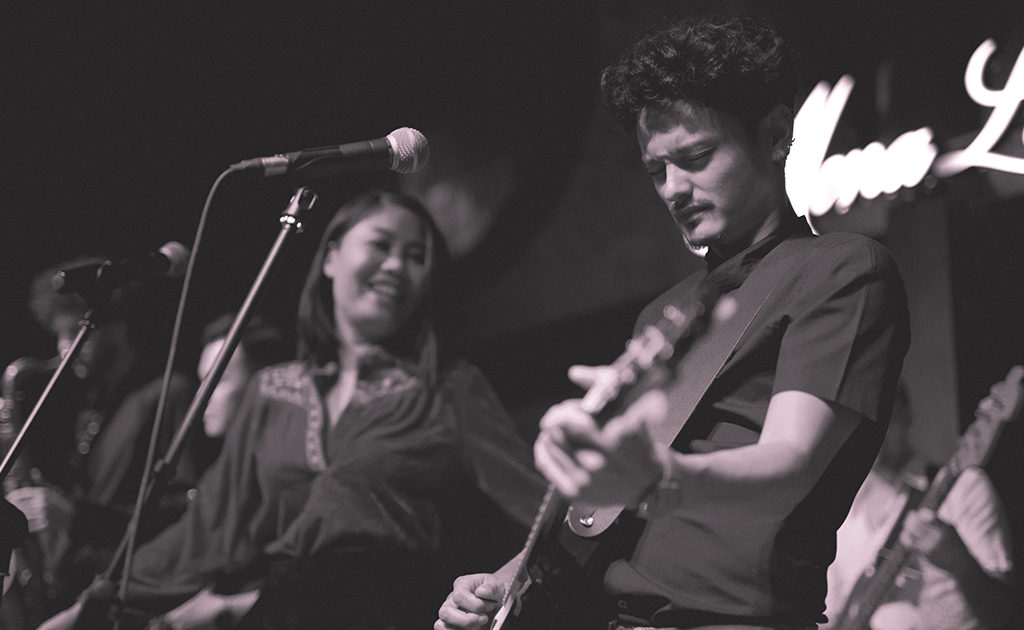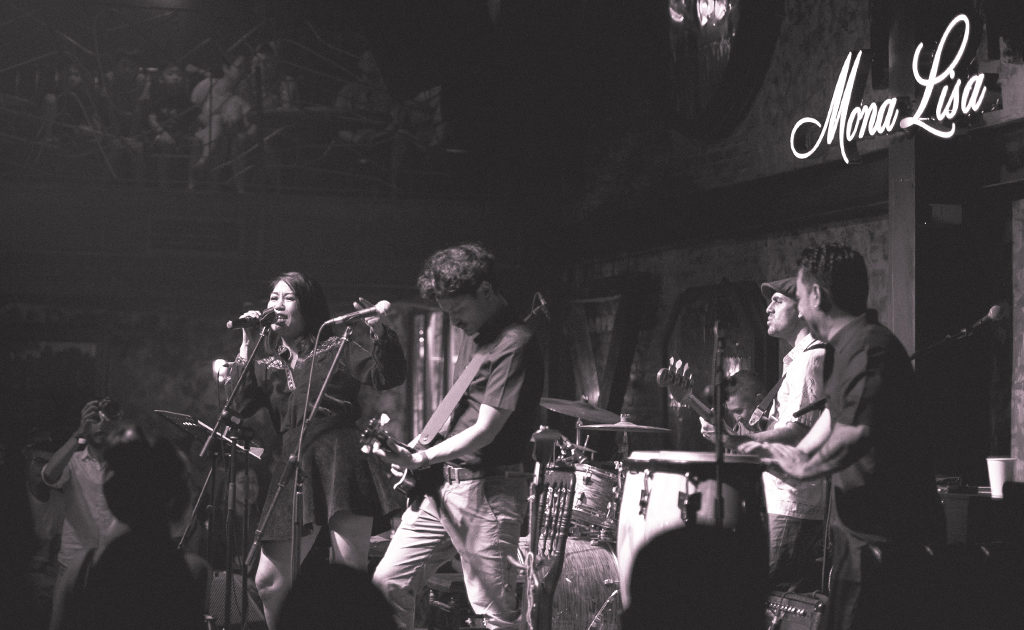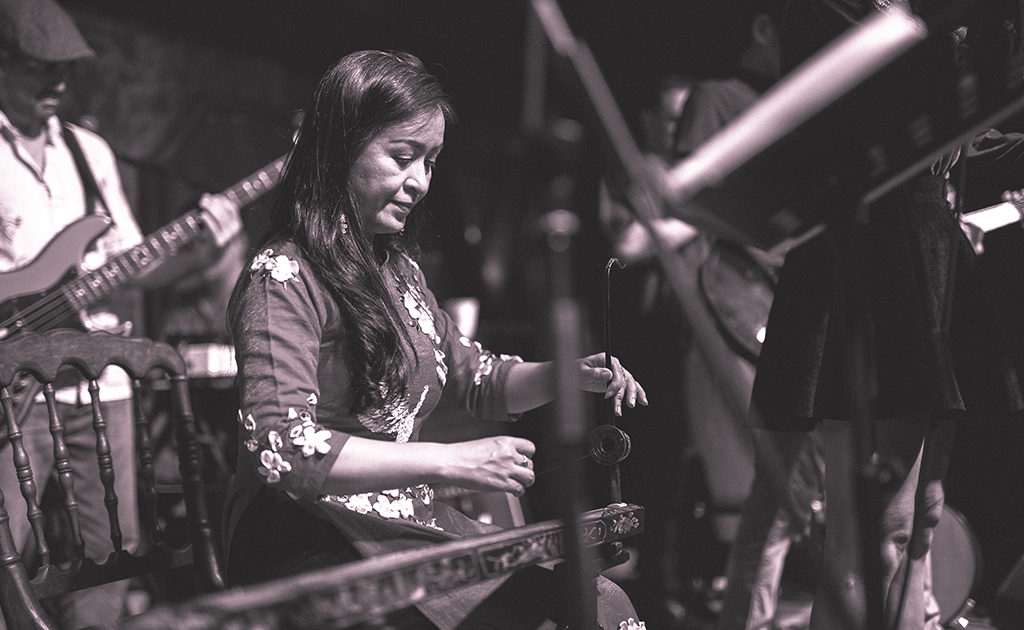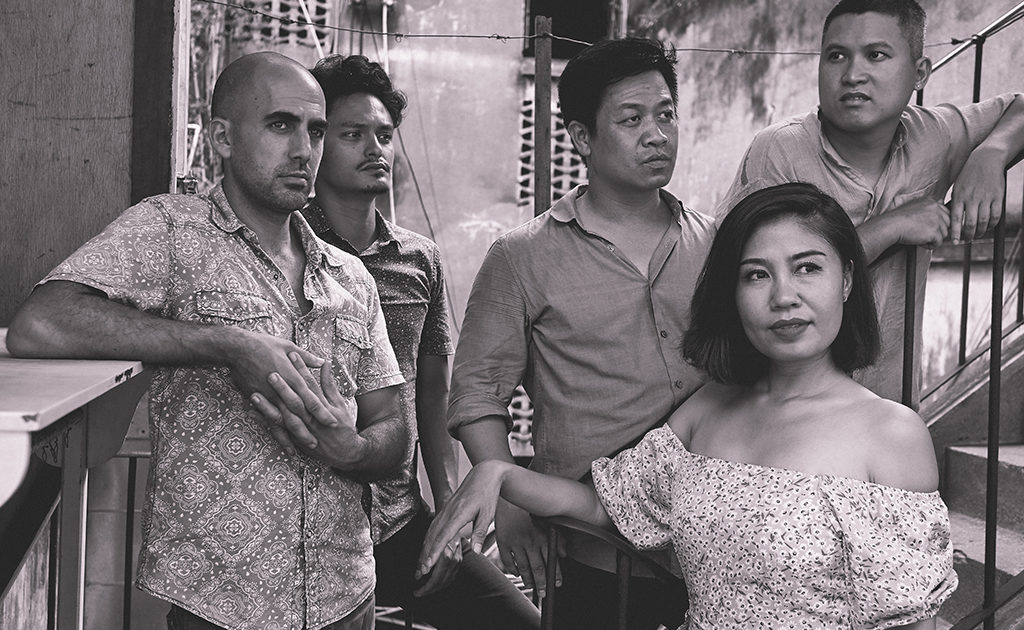Psychedelic guitar sounds mingle effortlessly with flavours of traditional Vietnamese music. Indy Laville, lead guitarist and the man responsible for the psychedelic part of this marriage, dives into another riff, drawing fresh applause from the crowd.
The Vietnamese sounds issue forth from an alien-looking instrument played by an impeccably dressed woman in a blue áo dài. The crowd goes deathly quiet as her hand glides over the one-stringed instrument, while the other manipulates the antenna-like rod producing strange and mesmerising sounds. The instrument is a Đàn bầu and the woman playing it is Nguyễn Thị Hải Phượng — a legend in the world of traditional Vietnamese music.

As the eerie melody dies away, lead singer Nguyễn Anh Minh launches into the next song with the raw and practised vocal control that only comes with years of experience. All eyes are on her as she sways and swings and weaves a story that is immediately understood, regardless of one’s proficiency in Vietnamese.
Outside of this room, it’s a chilly winter night in Hanoi; inside this room, it’s a warm summer’s night in late-1960’s Saigon — because Saigon Soul Revival has come to town.
Talking music of an age gone by
“Our sound is all over the place,” Indy starts, “It’s soul, it’s rock, it’s funk and R&B.”
I first met the band at a small cafe overlooking Hanoi’s famous St. Joseph’s Cathedral.
My mind immediately went searching for lofty and complicated metaphors, somehow combining the dour neo-gothic building with Saigon Soul Revival’s mission of shining new light on old music. Luckily for all of us, the band’s down-to-earth attitude banished all such poetic thoughts from my mind, and we quickly settled down into a relaxed chat.
Saigon Soul Revival

We spoke about everything — from the best bánh mì joint in the Old Quarter to the difference between the traffic of Ho Chi Minh City and the capital. After a short while, bassist Gabby Kaouros, keyboardist Trần Nam Kỳ, and drummer Nguyễn Hương Bảo Hiếu return with freshly procured bánh mì and we began to talk music.
Yeah,” Jan, the band’s manager adds, “what happened was in the 60s, you had all the US soldiers coming, and with them came their music, you know. And that music became the soundtrack of a generation.”
“And that’s the start of the Saigon Soul music scene,” Indy continues. “The Saigonese took this music and added their own influences to it, and it became not only soul music sung in Vietnamese, but Vietnamese soul music.” Bunch of musicians talk about the music, isn’t only the passion they have for this project, but also the excitement which accompanies that passion. It’s the kind of excitement you usually find among children who are shown something completely new.
“The Saigonese took this music and added their own influences to it, and it became not only soul music sung in Vietnamese, but Vietnamese soul music.”
And in part, that’s because Saigon soul music is still a completely new genre. Saigon Soul Revival is the only band delving into this rich history and reviving a music genre that would otherwise be lost. “We didn’t even really know anything about it,” Gabby admits, “We were sitting around talking about the kind of music we wanted to make, and then someone showed us this YouTube video, Saigon Soul.”

Indy smiles in reminiscence and adds, “Yeah, it had this picture of a woman smoking on it and the sound was so raw and real, it sounded almost like it was recorded in a garage.”
“It probably was!” Kỳ adds jokingly.
Họa Âm Xưa – A highwire act between old and new
It was precisely this authentic sound that the band was after as they stepped into the recording studio in May 2019 to record Họa Âm Xưa (Old Harmonies), a real continuation of the Saigonese sound of the 1960s. The end product is an album that is silky smooth throughout but raw in all the right places. The balance of covers and original compositions, modern and traditional influences, are exactly what forces the listener to return to this album — like someone tasting a new combination of flavours for the first time going back for another taste, and another, and another…
It’s also the reason why Họa Âm Xưa does not feel like a debut album, but rather a brilliant second album into which a lot of thought and dedication was poured. When asked about this, Gabby shrugs: “I think it was because we always knew we wanted to make an album, you know, from the start. So we’ve been thinking about it for three years.”
“And at the start, we only did covers,” Anh Minh says, “so we had a lot of time to get used to the sound before writing our own songs.”
“That made us better understand where the old sounds should go in, and where the new sounds should go, and where we should combine them, I think,”
“That made us better understand where the old sounds should go in, and where the new sounds should go, and where we should combine them, I think,” Jan adds, the rest nodding in agreement. I silently agree, thinking of the Ska version of Giây Phút Cuối Tuần, a classic from the legendary Mai Lệ Huyền, or Hào Hoa featuring acclaimed Saigonese rapper Blacka — both effortlessly mixing the sounds of modern Ho Chi Minh City with sounds of an age gone past.
Revive that funky music…
This combination of old and new — the picking up and relighting of a torch dropped in a previous generation — is why they call themselves Saigon Soul Revival. This band is on a mission to revive music which would have otherwise been lost.
The name wasn’t chosen as some kind of gimmick, or because it sounded cool; rather, it was chosen as a manifesto.

The song that best encapsulates this is Tình Nhạc Sỹ, a 1955 composition from the famous Vietnamese composer Minh Kỳ. What makes this song special is that it has never been recorded. Even when the band received the composition it was without any real sheet music, so they sat down and revived a song which, for all intents and purposes, was dead. And as we stood in that warm little enclave of Saigon in Hanoi, the last notes of the last song drifting to silence, we were left with a distinct sense of longing for a time and place that was briefly revived for our pleasure through the efforts of five passionate musicians.
And of course, one extraordinary lady in a blue áo dài.
STORIES
